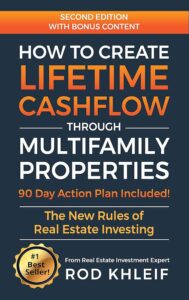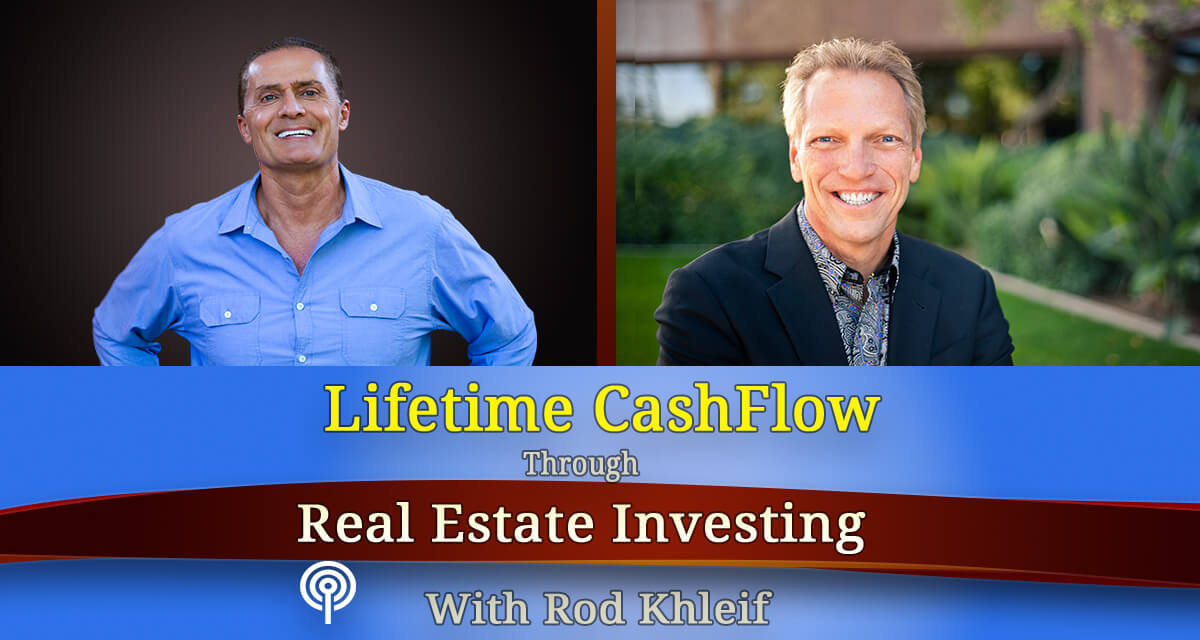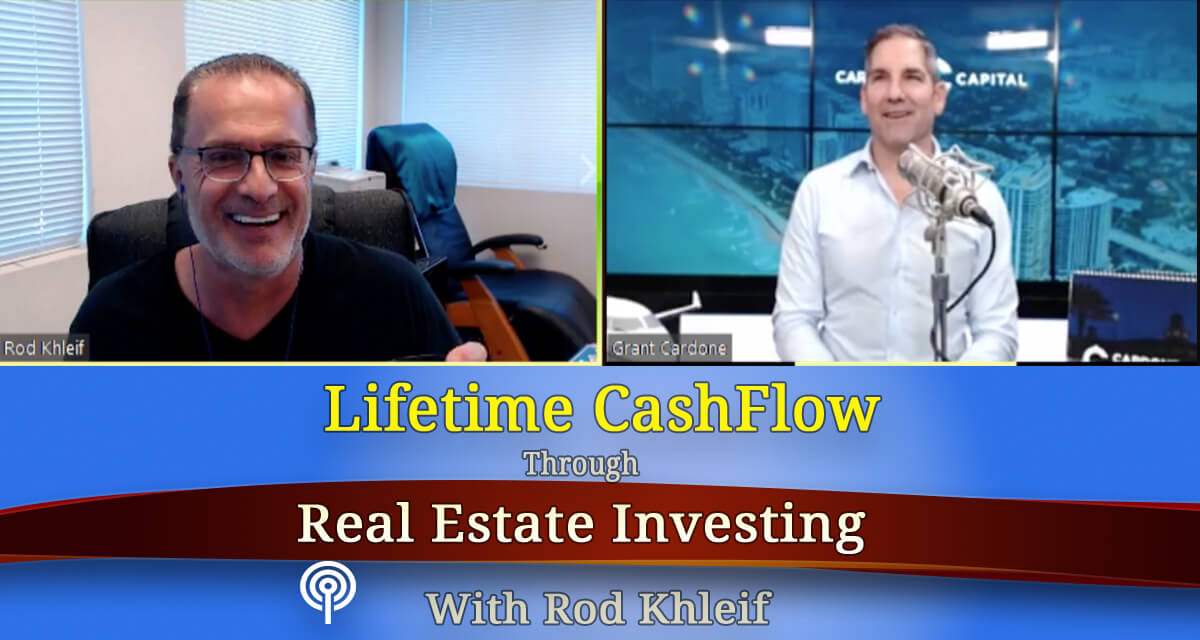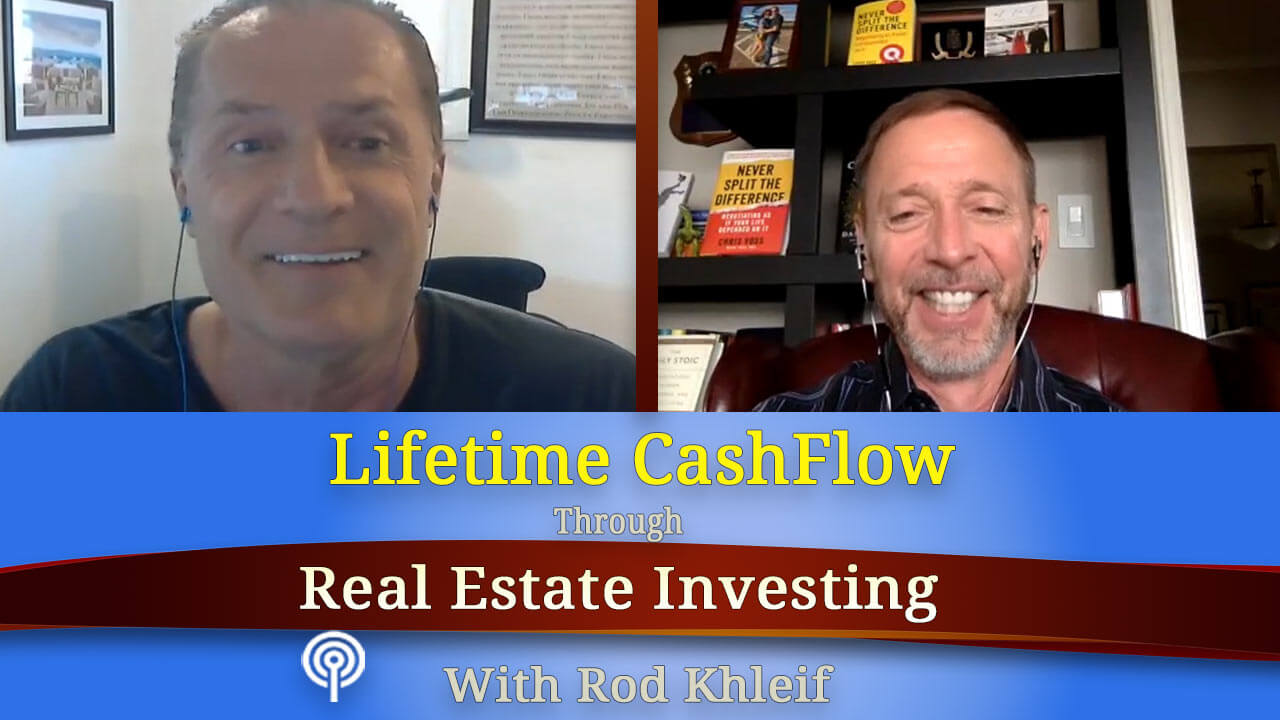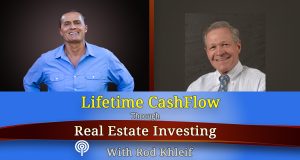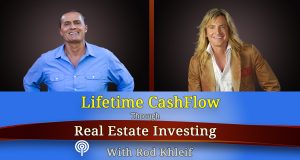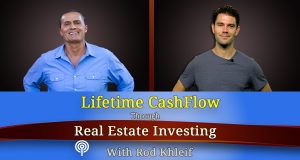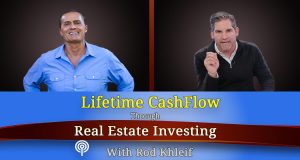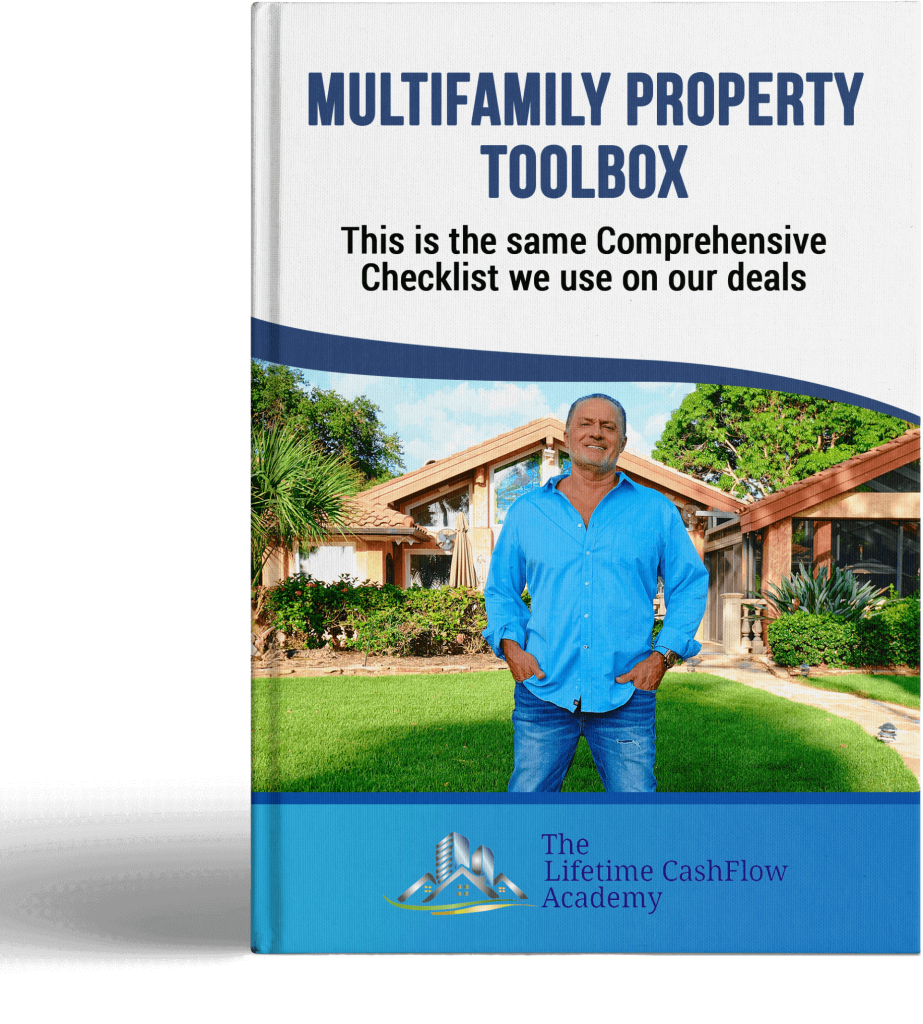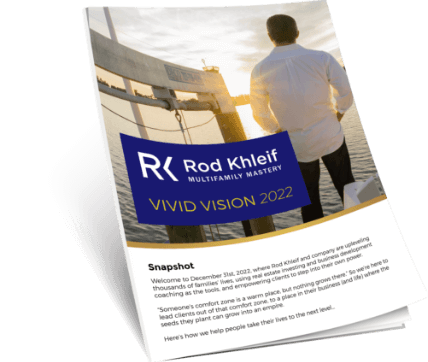Ep #443 Making Multifamily work in California
Building Multifamily Real Estate from the ground up.
- Workforce Housing
- Demographics of A vs B Class urban development
- 5 Bedroom Townhomes at scale
- Being a local change agent
- The stability of Multifamily Real Estate
- Proving the models
- Being recession resilient
- Build and hold vs build and sell
To find out more about our guest click here.
Full Transcript Below
Ep #443 – Scott Choppin – Making Multifamily work in California
Hi my name is Rod Khleif and I’m the host of the “Lifetime Cashflow through Real Estate Investing Podcast” and every week I interview multifamily rockstars. We talk about how they built incredible wealth for themselves and their families through multifamily properties. So hit the like and subscribe button and get notified every Monday when a new episode comes out. Let’s get to it
Rod: Welcome to another edition of How to Build Lifetime Cashflow through Real Estate Investing. I’m Rod Khleif and I am super thrilled that you’re here and you are gonna really enjoy the interview we’ve got going today. We’re interviewing gentleman named Scott Choppin and he’s the founder of Urban Pacific Group in Long Beach, California. And they are solely developers but they have developed a lot of stuff and so we’re gonna dig into that and particularly love the fact that its workforce housing which this country desperately needs. So welcome to show my friend
Scott: Thanks Rod. Great to be here and appreciate the invite.
Rod: Absolutely! Now I’m really looking forward to hearing a little bit about your story now. I read that your company has been around in since 1960 and you are not 60 years old. I recognize it
Scott: Yeah right yeah so the bio talks about that my family has been in real estate in Long Beach since 1960. So my uncle Mike Choppin formed a real estate development company so that was his claim but it really I make that statement to just demonstrate to people that I come from a deep background on the real estate development space that’s really all I’ve ever done so you know as you mentioned before pure real estate developer historically and today
Rod: So talk, I mean I usually ask the question how did you get in the business but obviously with your Uncle Mike that that’s kind of a forgone answer but maybe you could speak to a little bit how your progress happens you know in into this business and you know maybe how you first got started. A lot of people you know that listen haven’t taken action yet and you’ve got kind of a unique niche in that you know most people start out as investors and operators they don’t you know they buy existing value add whatever and you build it. So can you maybe give us a little background
Scott: Sure. No, I appreciate the question. So you know like lots of kids, when your family is in a certain business my Uncle Mike was in the business, my dad was in the business that was a thing for a while when I was young I didn’t want to do right like you know kids do. But I did a couple things, a couple key events happen for me Rod. So one is after high school I worked in the construction field for a couple years so you know I was a guy out of working on the site you know getting dirty every day and that taught me ultimately what I didn’t want to do right and good people, we still work with construction people you know daily and building our projects, salt of the earth, but I knew for me you know who I was and my personality wasn’t gonna be satisfied with that and plus you know by the way it’s just hard on your body it’s gonna limit the amount of money you can make. So I came to terms with that like it was clear to me that there was not a long runway for that space. Although at 18, I was making more money than any of my friends. But the second part of that was that it gave me the opportunity to observe what a project was like how did it go together right deeply familiar with like just building of you know wood frame apartment buildings. In fact, all the projects I worked on in construction where apartment buildings and I remember one day you know nothing to do with you know my family but the real estate developer who was you know building the building I worked on rolled up
Rod: in his nice car
Scott: you know wearing a suit you know in those days when people wore suits and I recognized I go, okay I get it now like from my family background and knowing what real estate developers did, this was the guy and I clearly showed up to me, ah, that’s what I want to do. And then the second really key for me was you know I’m a I’m a voracious reader I have been my entire life and at 18 I read you know one of the really famous you know 1950s era book “How to Make a Million Dollars Investing in Real Estate on the Weekends” right one of those you know famous books and what that did for me Rod was gave me the picture in to deal-making right. What it was to be an entrepreneur real estate to find projects in that instance it would be you know acquiring existing assets you know we didn’t call it value-added in those days but that’s ultimately what it was. And that cemented for me I got, oh now I you know I had the background for my family but the deal-making and the creativity and sort of the adventure to certain degree you know I was 18 right like it became clear to me and so really from that time on like 18-19 years old, I knew what I wanted to do and really every step I took from there for the college that I picked, the college major that I picked, the first several companies that I always thought was the most humble companies
Rod: What was the major?
Scott: Oh yeah so I worked actually for two companies one, people know today’s KB home and the day it was called Kauffman Abroad and I worked for a division there. So it was called the Multi Housing Group and we were an internal corporate offer, a syndicator and developer of apartment projects for KB or Kauffman corporate right not a retail offer. Nobody even knew we existed but I worked there for a guy named Mike Kosta, incredible real estate development talent basically you know started my career there and then later, I went for a little while to a company called, I worked with a company called Saris Regis Group which is a well known real estate development company based here in Orange County and it was after Saris that I left and formed what is now Urban Pacific Group and that’s been 20 years in operations. In fact this year
Rod: No kidding and so and high-level describe your, and maybe is the business model you started with the same thing that you’re doing now?
Scott: It’s it is different but there are common themes and
Rod: Alright, talk about how you started then. What did you start doing 20 years ago as Urban Pacific and then let’s work forward if you don’t mind
Scott: Yeah absolutely. So when I worked for Saris Regis Group, good group of guys very talented I worked for a guy named Jeff Stack there and Jeff at the time with his partners was investigating this was 1999 and where do we go right looking forward in the future and they hired a company called Robert Charles Lesser & Company or RCL Co they’re pretty well known national market research, market survey firm. And they at the time had a guy in Orange County named Bob Gardner right a great guy Bob I think is somehow I retired now though I think you still active but his whole philosophy was about urban housing. And in 1999-2000, living in downtown areas of any big city really wasn’t like a popular trend. It was really cutting-edge and I love Jeff good guy super you know super brilliant talent in the space but he didn’t want to do urban that wasn’t his thing. And it was sort of like the rapport just didn’t really go anywhere and it was really I looked at that thing and I go man that is really where I want to be working. I was 32 at the time, to me, it resonated urban housing loft housing in places like downtown LA and a lot of energy, a lot of excitement around that space, even if it wasn’t popular right. So started the company we named Urban Pacific really was to pursue urban infill real estate development that would be new construction. We did some adaptive reuse at the time taking old office buildings and converting them into loft housing and really we’ve been doing that for 20 years and then really we morphed into about three years ago, focusing entirely on the workforce housing space which was a move, which we can talk about to differentiate ourselves and it really was a combination Rod of my background working for Kaufman Abroad. We did affordable housing projects think section 42 low-income housing and then at Seris I did market rate. So it gave me a like a spectrum of product types that I had background in and ultimately the UTH or Urban Town House model which is a combination of those two. Basically, pairing private capital with a workforce housing rental model is how we speak it
Rod: Okay and so speak to what’s different about your niche in workforce housing and a normal, well normal’s the wrong word, an A-class developer that’s putting out high-end product. What are some of the differences and nuances? If you could speak to the differences
Scott: Sure. So let me first define what workforce housing means. Excuse me, Rod. So commonly, workforce housing when we speak when people speak about today is they’re talking about a value add think of B or C class asset in a B or C neighborhood which is acquired and maybe rents are maintained for families that live that right that would be I think the more common definition. For us, workforce housing is a new construction offer which makes it different but we’re still serving those middle-income or moderate income families. I think 80 to 120 percent of median income right but it is new construction. In your class A, luxury, you know urban podium type projects you know you’re gonna have a mix of studio and one bedrooms classically serving a Gen Z or millennial demographic right, largest demographic cohort in US history. Great market to be in demographic trends are there for you those folks that are in their lifecycle to move out and occupy units. But we always we did that product and up to 2016 you know we did you know multiple large institutional grade projects. But in 2016 we really start to get the sense that the market was starting to be over billed right. I mean 2016 was you know four years ago but we saw just little instances of really a lot of supply coming on board and downtown like downtown Long Beach and that gave us the opportunity to start to look around as we do looking to be contrarian, looking for the uncommon offer, and it was really at that point that we thought let’s look at something that’s an alternate product and with my background that I spoke before, affordable housing and market rate housing I started we started to just innovate and riff on the idea of serving them the middle-income population that makes too much money to afford or too much money they over qualify for government subsidized housing. But they don’t make enough money to afford the class-A luxury high rent and particularly small unit product right. Our tenant profile is a large you know blue-collar working family in Southern California right maybe six to eight people in the family importantly two to four wage earners what we call a multi-earner household and they’re not going to live in a studio right. They’re not gonna live in a one-bedroom they are looking for housing that’s coherent with their lifestyle, big family. They live in you know sort of not suburban neighborhoods but they’re not living in downtown you know and the sexy gentrifying neighborhoods. These are working-class folks and they live in working-class neighborhoods. And so we came up with the idea of UTH which was to serve this population with a new housing offer and we came up with this urban townhouse product which is evolved over the three years that we’ve been really purely executing on that plan but importantly we’re building a three-story townhouse rental product with five bedrooms and four baths, 1,750 square feet and a two-car direct access ground-floor garage. So the way we speak it is this is a rental product that’s purposely a design and built to house these families, multi-generational working-class families
Rod: 1750 square feet, did you say five bedroom four bath?
Scott: Correct
Rod: Wow and in two-car garage and so I’m assuming this is on a small footprint since you’re going up three storeys
Scott: Yeah so great question so originally we had the first project we did was a two-story four-bedroom three-bath that sort of had a bigger footprint and as we execute on that project, our first several projects Rod were what we call the demonstration phase because this product was so experimental. We didn’t want to take on a lot of risk of a brand new cutting-edge product and like not have it go well. So we basically stayed disciplined had four projects in this demonstration phase and the very first one was this two-story townhouse. Immediately we recognized we should have shrunk the footprint and go out the story so that is to increase density. So that’s exactly the move we made and you called it correctly and we’ve really moved forward from that point on with really sticking very closely to the original design of this three-story townhouse although we’ve refined it you know for several projects now
Rod: A couple of questions, so do you find buildings that you raise or do you find vacant land? infill land? or all the above? you know and so that’s the first part of the question. Second part of the question is, what are the typical, how many units typically on one of your projects? is it you know, I don’t want to guess
Scott: Yeah. No, great question. So we do you know to answer your first question we’re finding underutilized land assets. I think you know classically we find an old really small house from the 1920s era on a big lot with a right zoning right. That’s the sort of the narrative we have for it but we do regularly find vacant land you know in the infill environment, we find what’s available right so we’re developing an already existing urban fabric you know we’re not in green fields. So land is where we find it it’s underutilized that you know you know we’re acquiring a land asset now where the building burned down right but had the right zoning so that’s part of the criteria. The other one though is for land is we’re really looking for land parcels that are low and moderate income neighborhoods right. We’re not going into the high-end this would be another differentiator to your early question is the class A new construction assets would all be you know in the highest income neighborhoods you can find land right downtown LA right Irvine Business Center would be another location here in Orange County close by. We’re actually going the other direction. We’re looking for neighborhoods that are you know working-class neighbourhoods blue-collar low moderate income for a couple reasons one is good land purchase prices right more competitive land purchase prices but also we buy, I’m sorry?
Rod: I said that’s critical on your niche right
Scott: Yeah absolutely in fact it’s a competitive advantage that we can go into these neighborhoods because we don’t have competition and then the last part of that is you know zoning is an easier store right. We don’t have resistant neighbors. We always try to find zone sites when we can. So the second part of your question is a great question also which is the early phases the demonstration phase we stayed you know small right medium sized projects you know the institutional measurement of sizes
Rod: What does that mean with specificity
Scott: Well you know so we’re finishing a project right now that’s seven units in Orange County where our next project after that was 15 units and then right now where we’ve moved out of the demonstration phase and we’re working on a project no money that’s 85 units. So right now our spectrum is about 30-100 units in LA Northerners County markets although we have expansion you know design for San Diego, Bay Area, Portland, Seattle, and Denver. We’ve underwritten projects and all those markets and this this product works feasibility wise but also these are you know as you would expect major urban metros with this sort of tenant demographic that needs you know moderate income you know naturally affordable housing right. This is a story across the U.S. really
Rod: Which I would guess that makes it easier for you to increase density wherever you can and get through the city and the county because there’s such a huge need for this. I don’t want to assume but I’m assuming that’s the case makes it
Scott: Yeah I love the logic but we’re talking about municipal governments here and you know that maybe sometimes works maybe doesn’t. And I will tell you this, in California, there’s a movement of a lot of particularly younger you know millennial GenZ generation folks that are really looking at a future of housing costs that is out of reach for them, young bees they’re called, yes in my backyard and they’re really making a lot of noise and actually getting some good law you know laws passed and you know facilitating the political process where we’re now really in a radically different environment in California. Now we still are in that push-pull environment where we’ve got this group pushing for new laws you know of course the real estate business is itself looking to do that. But then you have an entrenched you know population as you do in almost any city least bigger metro areas that you know is resistant to growth like they like it just like it is. And by the way it’s human nature right as a developer I’ve learned that we’re a change agent right. We come into a neighborhood and our job is to make a profitable project for ourselves and investors and we have, we you know implement change like that’s like that’s really fundamentally what we do. And so one of the things we do with UTH Rod is we really focus on already zone sites where we can go in and just do a set of construction drawings and some submit straight to plan check and skip any rezoning entirely
Rod: Nice nice well that makes it a whole lot easier and more scalable for sure yeah you know I was, one of my questions was going to be does this only work in California where we know rents are insane. But then you brought up San Diego of course, Bay Area, no question, Seattle, no question, and then you said Denver which is where I lived for 30 years. So I know what happened there as well. I used on 500 houses there and biggest mistake I ever made in my life was selling those but you know incredible opportunity there for sure no question. I went to high school there but okay. So let me ask you this now, is your strategy build and hold or do you ultimately sell? do you ultimately refinance? do you, I mean are you are you building these assets to hold long term and that’ll queue up? A second question which is you know do you battle pool them? Do you put in the hard floors do you put in the countertops and the cabinet’s that are gonna last. So two part question are you gonna hold them, you sell them, or and then what do you do to battle proof them?
Scott: Yeah I know you know spoken as a great multifamily owner yourself coming from that I recognize that place. So yeah great question, in the beginning during the demonstration phase we needed to prove the model right when you just like say it worked economically feasibility wise we needed to prove the rents worked nobody does five bedrooms at scale right we needed them know we could build it right what are the construction costs. We were in a rising construction cost environment for you know a decade plus. And then really any apartment dealmaker the most important thing is what’s its value at sale? or what’s its value refinance right? So the first three projects we sold, those were all in Long Beach the great race capital paid back the investors within a couple years, produce 22.6 IRR across that three apartment deal portfolio and then the fourth project in Fullerton the one I mentioned previously and we like the model now so much Rod that we’re gonna hold it forever right. That’s the narrative we have and of course we need to be coherent with the capital markets. We raise capital probably from high net worth individuals and families and family offices. This is really isn’t an institutional product yet you know we need to scale it more I think for the equity checks to get big enough for that and we have relationships there and we’ll move that way. But right now it’s you know those other folks that I mentioned and so yeah then the question becomes you know how do we build the projects differently now that we long term hold. So now every project we do from Fullerton, Montebello, Almaty that I’ve all mentioned we’re gonna hold all of those long term and so we orient a little bit differently but you know honestly Rod only a couple key places right everything would basically have been a generally good apartment grade build specification no matter what. So we’re doing you know a production style cabinet but it’s you know it’s a decent product we make it locally here so we take that you know that the China supply chains out of play here. We got a cabinet shop locally that we’ve basically give them all of our work and he’s able to produce at volumes that we need that are sufficient to supply the units that we’re building you know nice you know product self-closers. We use quartz countertops and then we have you know this epoxy base vinyl plank that we use throughout and that’s really the predominance of you know all the living areas, hallways, entry halls, all have this you know this final plank fluorine. And then on our early projects we were doing carpet in the rooms and we’re gonna move away from that now so I think in in our Montebello project which is under construction now, we’re gonna keep that. So I think we’ll do all the vinyl plank throughout you know kitchens, bathrooms, hallways, bedrooms, but it really looks the product we’re using looks like a relatively real wood floor and then the beauty of it with this resin base it’s not a wood base with a you know vinyl on top, it’s of this resin so I mean you can you know use that stuff all day long yeah and you know it’s gonna be robust really they call it waterproof is how the flooring companies. Other than that you know that’s really the only changes you know appliance packages would be similar you know we’re doing a mid grade appliance package but everything else, these are all have you know heating and cooling you know we do an Orange peel speck on the on the drywall you know we’re in California so a lot of our specs are like higher than yet other states. So energy efficiency, title 24, you know we’re using 5h drywall throughout you know the framing is beefier because guess what we’re in California with the seismic. So that just as a natural sort of process that we’re doing and then then this year lucky for us we get to install solar in every unit that’s now a mandate from the state of California
Rod: Wow so that lends my next question which is how do you accomplish this at a cost per square foot including the land and the constructor. So let me ask you this question, what is the cost per square foot just for what’s above the ground for the construction in the product that you’re doing right now. Now I it’s gonna go down with what’s happening in the environment but what has it been?
Scott: Yeah so the way I’ll speak it is were right now at about a $130 a square foot and leaseable, but that’s not just for the building, that’s all in so that’s utilities in the street which you know we don’t do a lot but
Rod: That’s the land? that’s the land too?
Scott: Oh not sorry that that’s all the construction sites work, okay so that’s a dollar 30 and you’re right on the money we’re already seeing signals in the subcontract markets that those prices are coming down. So we just bought out the stucco contract on our Montebello project, 25 percent savings like immediately and that’s you know for two reasons which you were already seen media effects is a lot of additional labor now coming into the marketplace during the lockdown. Projects are shutting down and so those that are still active and construction is considered essential in California we’re very lucky that way. So we’ve been able to continue under construction not all cities are staying open some have closed right so you can’t get inspections we’ve been fortunate that all of our active projects are open but I will tell you Rod, we, for the last year, year and a half we really haven’t acquired much because land was getting too expensive and construction costs were rising and we were just not, like the returns were just not getting us excited so we sort of naturally ramped down anyways and you know of course like you guys we were like 10-year economic expansion longest in US history you know you and I went through 2008 you know we start to look for the signals and go it’s coming we don’t know when we don’t know what will trigger it but let’s be disciplined let’s not have a boatload of you know product that we got a lease up if it the market turns against us so we naturally sort of pared down and then also that gave us part of the reason we went to the long-term hold was in anticipation of a downturn, we saw how apartment communities performed in the ’08-’09 recession Southern California and unless they had debt distress or just owner distress because they couldn’t manage it correctly, a well-run you know with good maturity lengths in the future dates for their financing did fine right. In fact they very stable you know occupancies stable rental revenues and so we really took a lesson from that and just said look that’s the product we want to be in so you know we used to do for sale condo. We stopped doing that you know and you know at 2008 when we got out of market but you know not because we didn’t like that space although we don’t like it but more we just firmly believe that the rental story particularly in markets like California is so strong that there’s no reason for us to be doing anything but that. So running to long term hold was really defensive from a recession also
Rod: And what do you buy that someone else pays off right I mean you know that’s
Scott: Yeah yeah where do you reinvest it’s you know better than you know and we’re not like you know we’re not drinking our own Kool-aid by the way I’ve seen you know our only our product but you know we are able to develop at values really the way I think of it Rod is when you’re a developer you know you should be developing at Cost below values right. It’s the opposite of below replacement costs and now in this recessionary environment we’ll start to look at assets that are priced you know below replacement cost right distressed assets if it cost you a 100k door to build you should be buying at eighty. We’re not there yet we’re early in the cycle for that July
Rod: We’ve got some under contract that fit that bill right now actually but they’re gonna be a lot more of them for sure and I would guess that you have no trouble filling your units like that, am I right? I mean
Scott: Yeah you are. In fact, before the recession to the 2020 recession, the move that we’re making was really an affordability move, In other words, these families occupied our units because we were at a lower cost alternative for them to rep but more importantly these are multi earner households right. So six to eight people two to four wage earners and what that does is it gives them a very stable stance in the marketplace right. So if you got four wage earners if one person or two people lose their jobs, it doesn’t destroy the income stream for the family. In fact I call it the economic sharing model which amongst the family group they’re sharing incomes and expenses across the larger family group with multi earners right and that we saw 2008 and then we saw you know really from our experience you know in this space you know for many many years that these families are their working-class families they want to maintain you know good life for their family they have strong social networks their kids are in school their churches down the road their extended family lives you know around where they are living now all we’re doing is giving them a space to move into that’s coherent with their larger family lifestyle right so they may be living in to two bedrooms that are close by or side by side. We’re pulling them out of those units into ours what we call recombination really it’s a combining of a family group together and these are related families mind you although there is a roommate story here as well. So you know now today in you know May of 2020, this recombination economic sharing model is perfectly situated for now what’s happening which is layoffs are hurting single earner households that may be living on their own or maybe with one roommate. They’re challenged when they lose their job to maintain the occupancy in that unit and so you’re seeing that product be challenged right think like you know work force housing BC value add, one bedrooms right. That’s gonna be challenging so we’ll class a you know studios and ones as an example. Where are they going? They’re going into larger units and that’s right the space that were awesome but also interesting enough in the coronavirus era a couple of things our density allows every unit has its own front door right. No common hallways, no elevators, no you know entry lobbies, you know you walk out your front door and you’re out in the outdoors. And then two is, these five bedrooms what we’re seeing is people will be you know occupying four bedrooms and they’re gonna keep that fifth bedroom to work at home or like we had one family that had two college students and that was gonna be their study room. So we’re seeing some interesting dynamics now that we didn’t anticipate right you know the work at home movement and particularly effort to be so like radically changing
Rod: Zoom went from 10 million users a day to 300 million. I mean it’s it’s happening right now and I interviewed a doctor in and he said it’s a new normal. Now let me ask, this just satisfy my own curiosity. You’ve got a two-car garage got a five bedroom townhouses, os the garage the ground-floor and then there’s a up the side then so that. So the first living floor is above the garage?
Scott: So yeah so the way I described it so on the ground floor of your three floors you got a two-car garage and then you have an entry for your front door and then we on all of our units one of the bedroom bathroom combos is on the ground floor to make it truly multi-generational right. So grandparents, grandmother, grandfather, elder in-laws anybody who had mobility issues they’re gonna be in that space although that would be the home office for some people that choose that then you go up a set of stairs middle floor would be a big combined kitchen dining living you know we do kitchen island we got the quartz countertop so it’s a you know it’s a good you know space for a family of this and then another bedroom bathroom on that floor and then you go up another stairs to the third floor and then you have three bedrooms and two bathrooms on that top floor one of which is the master you know has an Onsuite bathroom with you know in combination with that bedroom
Rod: Got it got it. Wow fascinating. I’d love to see the the floor plan for that it’d sounds fascinating was it so it’s about 1700 so what is it per floor then?
Scott: Well so the 1750 a great question the 1750 does not include the garage attic 400 to that unit 1750 plus 400 divide that by three. Four bedrooms you know we’ll have you know the Masters twelve by twelve right the Onsuite bathroom so it’s decent size not you know some people go wow that must be a lot of small bedrooms and they’re really not I mean we have you know our average is 10 to a 10 by 10 10 by 11 right we try to do cantilevers to expand the bedroom space where we can what, I mean we’ve refined these unit plans Rod to life to that nth degree we built them several projects we’re continuing to refine it you know remove the complexity you know tune up the specs. So we’re just production oriented housing and this is the most production I’ve ever been in my career which you know I’m loving in this. We’re all about removing complexity from the developer process anyway
Rod: Well especially right now because the opportunity is coming for you for sure I mean there’s gonna be incredible opportunities for your niche no question. Well listen Scott I really appreciate your valuable time fascinating business model, Urban Pacific Group is the name of his company thank thank you so much for sharing your story my friend really really very enlightening
Scott: Thank You Rod. Appreciate the opportunity. All right take care buddy
Scott: Thanks all right




